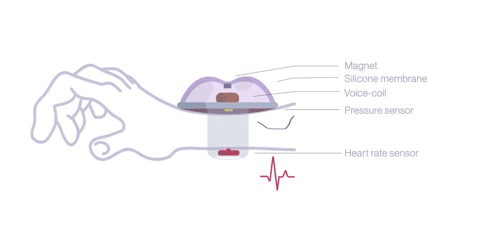KYUNG
YUN
CHOI
ambienBeat: Mobile Tactile Biofeedback for Subliminal Heart Rate Rhythmic Regulation
ambienBeat is a mobile heart rate regulator which provides closed-loop ambient biofeedback via subliminal tactile stimulus based on a user's heartbeat rate variability (HRV). We applied the principle of interpersonal physiological synchronization to achieve our goal of effortless regulation of HRV, which is tightly coupled with mental stress levels. ambienBeat provides various patterns of subliminal tactile stimuli, which mimics the feeling of a heartbeat pulse, to guide a user's HRV to resonate with its rhythmic, tactile patterns. The strength and rhythmic patterns of tactile stimulation are controlled to a level below the cognitive threshold of an individual's tactile sensitivity on their wrist so as to minimize task disturbance. Here we present an acoustically noiseless, soft voice-coil actuator to render the ambient tactile stimulus and present the system and implementation process. We evaluated our system by comparing it to ambient auditory and visual guidance. Results from the user study shows that the subliminal tactile stimulation was effective in guiding a user's HRV to resonate with ambienBeat to either calm or boost the heart rate using minimal cognitive load.

(a) ambienBeat, a wrist-worn mobile biofeedback system for helping users’ body to regulate HR. (b, c) ambienBeat can beworn in various circumstances with minimal effect on task engagement (d) It can be alsoworn during relaxing activities (e.g. reading a book, writing a journal) to keep a stable pace of heart rate. (e) Meditation assistant application

ambienBeat in different shapes (a) Dome-shaped ambienBeat on wrist (b) Bean-shaped ambienBeat (c) Unfastened ambienBeats (d) Fastened ambienBeats
Working Principle


We fabricated an electromagnetic field-driven soft actuator using a customized voice-coil and molded a silicone membrane with a neodymium magnet (Grade N52, 5233 Gauss Disc magnet) embedded, as this does not produce unwanted acoustic noise. A barometric MEMS pressure sensor (MPL115A2, NXP) was embedded in the silicone for a touch sensitive pressure sensor. We placed it on the bottom part of the device. It is used for getting feedback of the force produced by the voice-coil soft actuator.
Inside of the ambienBeat


Electronic components of ambienBeat. (a) Inside of the soft actuator. (a-1) Silicone membrane with a
neodymium magnet. (a-2) TIP120 Mosfet for controlling the current through the voice coil (a-3). (a-4) RGB LED for turn ON/OFF, Run indication. (b) Li-po batteries (c) ON/OFF Switch. (d) Microcontroller (e) Female button electrode for pulse sensor data transmission from the strap-b. (f) Two conductive thread strips that hold conductive Velcro for the power connection of the pulse sensor from the strap-b.
Application Scenarios

Self-awareness
With the main functions of ambienBeat and as the results of the user study show, ambienBeat may be helpful for practicing meditation instead of being guided by visual or auditory instructions via a smartphone app. Instead of holding or placing the 2D display device in front of them and trying to focus on the information displayed through the screen or the device itself, users could fully focus on their inner state through ambient tactile stimulation, as if it were a peripheral organ of their body. Also, it could be an enhancement assistant accompanying conventional visual or auditory guidance.
Boost Up Heart Rate (HR)
As evaluated by the user study, When users are under situation that needs a certain mental tension, ambienBeat can be used for increasing the heartbeat rate. The animation on the right demonstrates examples of its usage in driving a car. For example, when a driver starts to get sleep, which can be indicated by HR analysis and the decrements of R-R interval, ambienBeat
can produce a tactile stimulation of faster frequency to boost up the HR of the driver.







